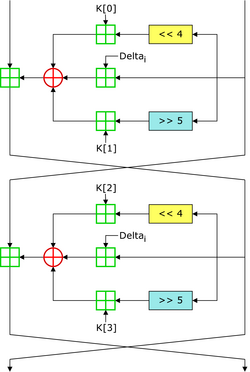
The Advanced Encryption Standard (AES), also known by its original name Rijndael, is a specification for the encryption of electronic data established by the U.S. National Institute of Standards and Technology (NIST) in 2001.
In cryptography, 3-Way is a block cipher designed in 1994 by Joan Daemen. It is closely related to BaseKing; the two are variants of the same general cipher technique.
In cryptography, Skipjack is a block cipher—an algorithm for encryption—developed by the U.S. National Security Agency (NSA). Initially classified, it was originally intended for use in the controversial Clipper chip. Subsequently, the algorithm was declassified.

The GOST block cipher (Magma), defined in the standard GOST 28147-89, is a Soviet and Russian government standard symmetric key block cipher with a block size of 64 bits. The original standard, published in 1989, did not give the cipher any name, but the most recent revision of the standard, GOST R 34.12-2015, specifies that it may be referred to as Magma. The GOST hash function is based on this cipher. The new standard also specifies a new 128-bit block cipher called Kuznyechik.

In cryptography, the Tiny Encryption Algorithm (TEA) is a block cipher notable for its simplicity of description and implementation, typically a few lines of code. It was designed by David Wheeler and Roger Needham of the Cambridge Computer Laboratory; it was first presented at the Fast Software Encryption workshop in Leuven in 1994, and first published in the proceedings of that workshop.
A5/2 is a stream cipher used to provide voice privacy in the GSM cellular telephone protocol. It was designed in 1992-1993 as a replacement for the relatively stronger A5/1, to allow the GSM standard to be exported to countries "with restrictions on the import of products with cryptographic security features".

In cryptography, RC2 is a symmetric-key block cipher designed by Ron Rivest in 1987. "RC" stands for "Ron's Code" or "Rivest Cipher"; other ciphers designed by Rivest include RC4, RC5, and RC6.
In cryptography, Khufu and Khafre are two block ciphers designed by Ralph Merkle in 1989 while working at Xerox's Palo Alto Research Center. Along with Snefru, a cryptographic hash function, the ciphers were named after the Egyptian Pharaohs Khufu, Khafre and Sneferu.
In cryptography, the Cellular Message Encryption Algorithm (CMEA) is a block cipher which was used for securing mobile phones in the United States. CMEA is one of four cryptographic primitives specified in a Telecommunications Industry Association (TIA) standard, and is designed to encrypt the control channel, rather than the voice data. In 1997, a group of cryptographers published attacks on the cipher showing it had several weaknesses which give it a trivial effective strength of a 24-bit to 32-bit cipher. Some accusations were made that the NSA had pressured the original designers into crippling CMEA, but the NSA has denied any role in the design or selection of the algorithm. The ECMEA and SCEMA ciphers are derived from CMEA.
In cryptography, mod n cryptanalysis is an attack applicable to block and stream ciphers. It is a form of partitioning cryptanalysis that exploits unevenness in how the cipher operates over equivalence classes modulo n. The method was first suggested in 1999 by John Kelsey, Bruce Schneier, and David Wagner and applied to RC5P and M6. These attacks used the properties of binary addition and bit rotation modulo a Fermat prime.
In cryptography, NewDES is a symmetric key block cipher. It was created in 1984–1985 by Robert Scott as a potential DES replacement.

Ian Avrum Goldberg is a cryptographer and cypherpunk. He is best known for breaking Netscape's implementation of SSL, and for his role as chief scientist of Radialpoint, a Canadian software company. Goldberg is currently a professor at the Faculty of Mathematics of the David R. Cheriton School of Computer Science within the University of Waterloo, and the Canada Research Chair in Privacy Enhancing Technologies. He was formerly Tor Project board of directors chairman, and is one of the designers of off the record messaging.
The security of cryptographic systems depends on some secret data that is known to authorized persons but unknown and unpredictable to others. To achieve this unpredictability, some randomization is typically employed. Modern cryptographic protocols often require frequent generation of random quantities. Cryptographic attacks that subvert or exploit weaknesses in this process are known as random number generator attacks.

In cryptography, the boomerang attack is a method for the cryptanalysis of block ciphers based on differential cryptanalysis. The attack was published in 1999 by David Wagner, who used it to break the COCONUT98 cipher.
In cryptography, impossible differential cryptanalysis is a form of differential cryptanalysis for block ciphers. While ordinary differential cryptanalysis tracks differences that propagate through the cipher with greater than expected probability, impossible differential cryptanalysis exploits differences that are impossible at some intermediate state of the cipher algorithm.
Alex Biryukov is a cryptographer, currently a full professor at the University of Luxembourg.

In cryptography, Twofish is a symmetric key block cipher with a block size of 128 bits and key sizes up to 256 bits. It was one of the five finalists of the Advanced Encryption Standard contest, but it was not selected for standardization. Twofish is related to the earlier block cipher Blowfish.
This article summarizes publicly known attacks against block ciphers and stream ciphers. Note that there are perhaps attacks that are not publicly known, and not all entries may be up to date.
In cryptography, a round or round function is a basic transformation that is repeated (iterated) multiple times inside the algorithm. Splitting a large algorithmic function into rounds simplifies both implementation and cryptanalysis.







